Gravlax is fresh salmon that’s been cured with a combination of salt and sugar. It’s arguably the ultimate easy-to-make luxury food in the world! This homemade Cured Salmon Gravlax recipe can be made with a small fillet or whole side of salmon, and costs a fraction of store bought.
The beauty of homemade cured salmon is that you can control the salt so it’s not too salty and it’s got a fresh herb flavour that you’ll never get in a packet! Also, don’t miss the stunning Beetroot Cured Salmon!
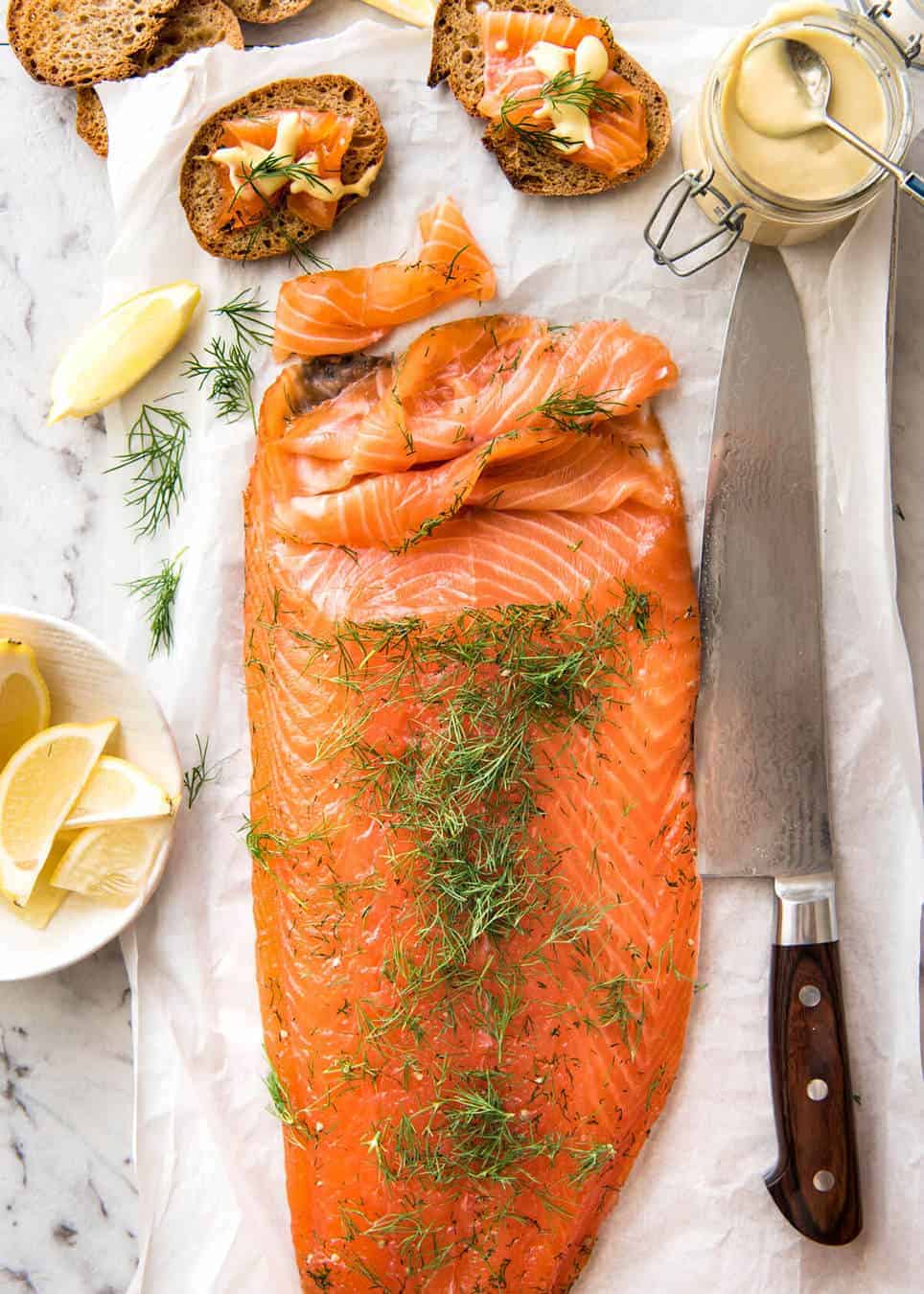
Gravlax recipe
I’ve made cured salmon gravlax a bunch of times over the years and my results were varied. Never any epic disasters, they were always edible. But sometimes they were over cured, under cured, and the biggest problem I’ve had is over salted salmon.
If you’ve invested in a beautiful sashimi-grade piece of salmon, it’s almost criminal if it’s so salty that it overpowers the salmon!
If you search around on the internet, you’ll find that the ratios of salmon to salt and sugar and curing times are absolutely all over the place. Some recipes use as much as 750g/1.5lb salt + sugar to 1 kg / 2 lb of salmon. Some recipes use as little as 175g/6oz of salt + sugar. Then curing times range from 12 hours to 3 days.
Now finally, I have Cured Salmon Gravlax Recipe that’s a keeper with the right ratio of salt and sugar:
Salmon Gravlax formula
Equal parts salt + sugar (combined) 50% of the weight of the salmon. Coat, leave 24 hours for lightly cured, 36 hours for medium (this is what I do) and 48 hours for hard cure.
The biggest problem with gravlax recipes is that they are usually far too salty!
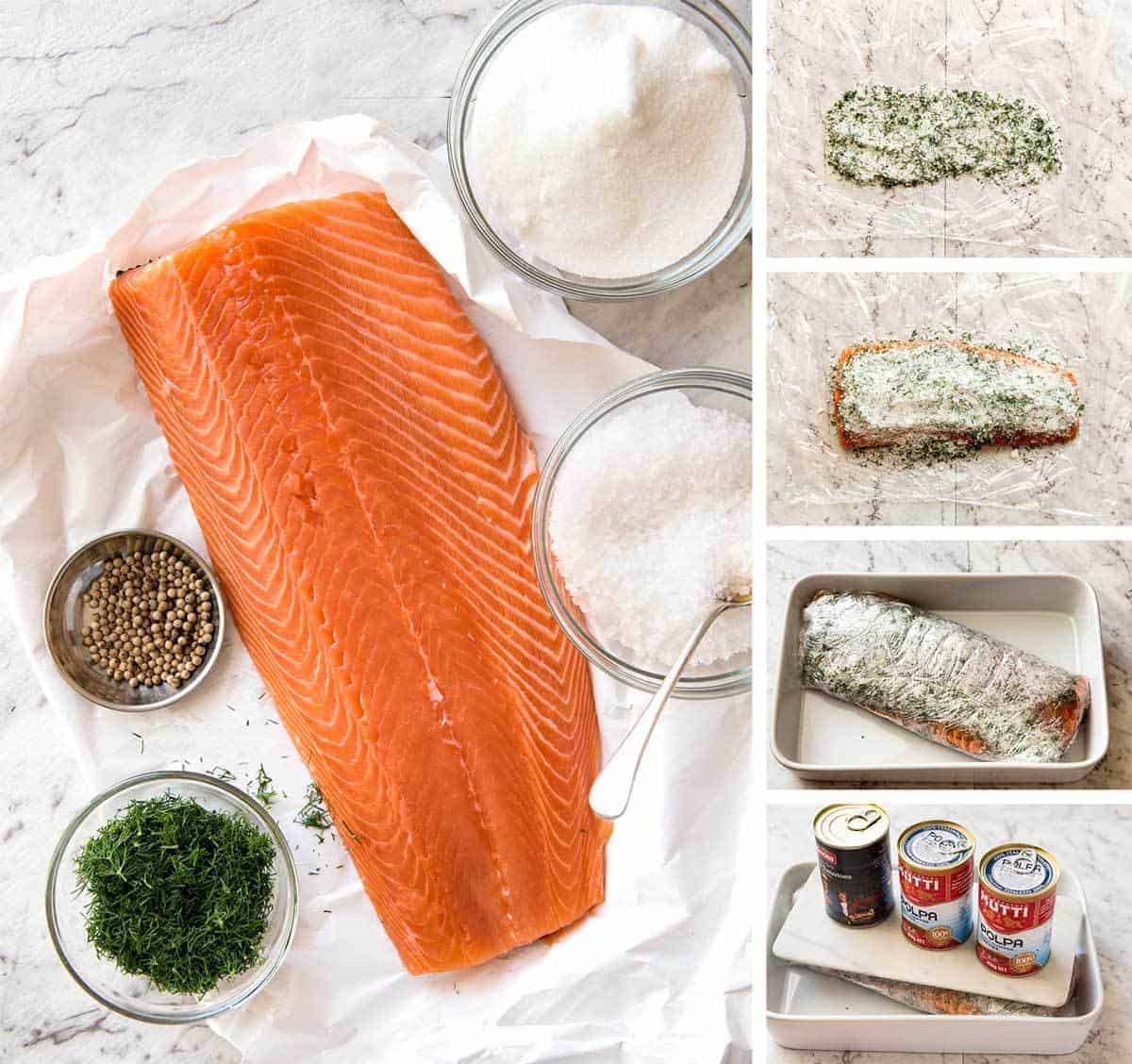
What does gravlax taste like?
Gravlax tastes like a cross between salmon sashimi (imagine it with the addition of seasoning from salt plus fresh herb flavour), and the smoked salmon slices you buy at stores – but minus the smokey flavour (because smoked salmon is made by smoking salmon).
This Cured Salmon Gravlax recipe is perfect. It’s not too salty, the flesh is not overly cured i.e. still nice and moist. But it’s cured enough to be easily sliceable into thin pieces (which is virtually impossible with raw fish). It’s salty enough that you’ll want to eat the slices plain, but not too salty that you’ll need to guzzle a glass of water with every bite. <- Problem I’ve had in the past!

Difference between gravlax and smoked salmon
Smoked salmon and gravlax are actually quite similar in flavour and texture in that they both have a moist, silky texture that is “raw-like”, rather than hard like jerky or cooked. But the big difference is that smoked salmon is made by smoking raw salmon at a low temperature which infuses the salmon which smokey flavour which gravlax does not have.
Other than the smokey flavour, they are actually quite similar! In fact, you can use this homemade gravlax in place of smoked salmon in all my smoked salmon recipes, including Salmon Quiche, these Smoked Salmon Appetizer Bites and this Smoked Salmon Dip!
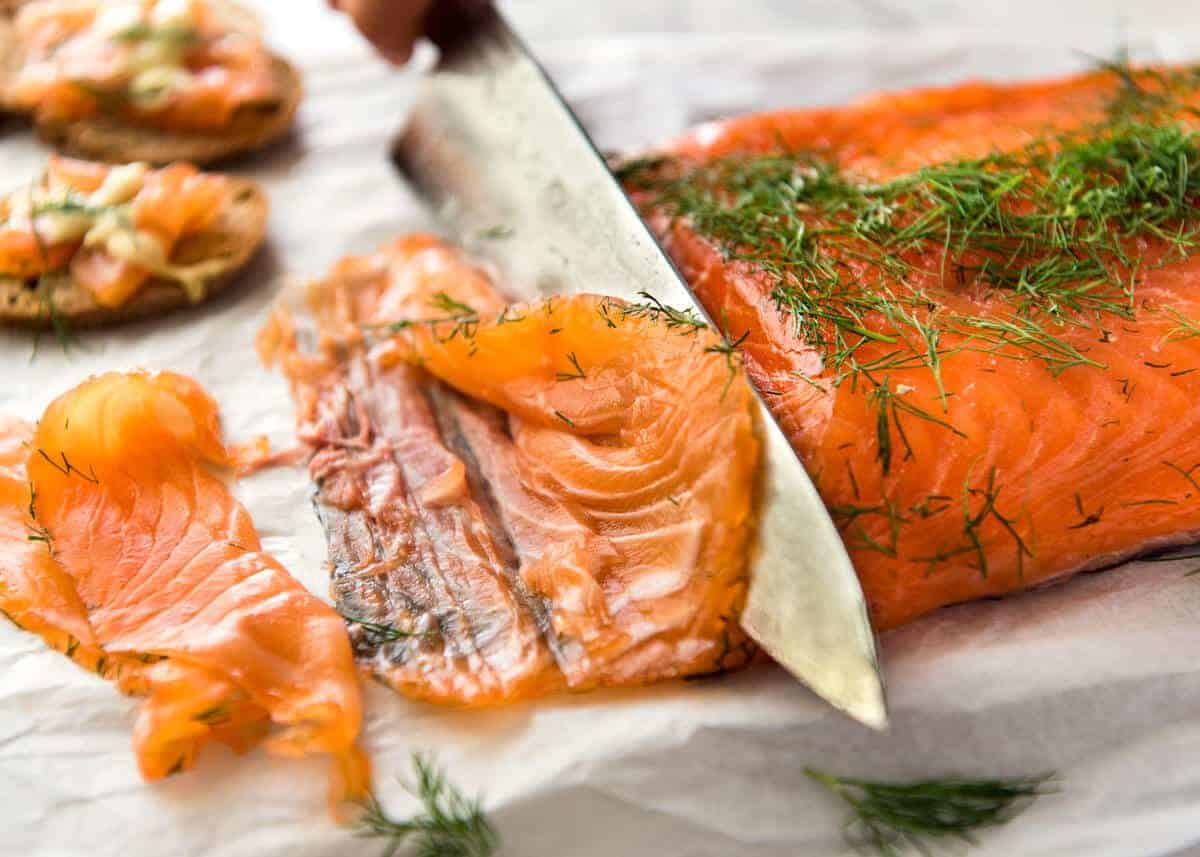
Salmon Gravlax FAQ
Can you make gravlax with frozen salmon?
Yes you can, as long as you use high quality salmon (ie don’t use vac packed salmon from the supermarket that’s been sitting around for days or box packet frozen salmon from Costco or Aldi). Freeze it yourself to -10°F / -23°C for at least a week, or use commercial frozen salmon from a reputable fish monger.
How long does gravlax keep?
It depends on how much you cure the salmon. I would not keep lightly cured salmon (24 hours) beyond 36 hours at most (just to be safe). Medium cured salmon (36 – 48 hour cure) for 2 days to be safe, but 3 should be fine. Hard cured salmon (3 day cure) can be kept for 5 days.
Can you freeze cured salmon gravlax?
Yes you can, just like you can freeze store bought smoked salmon slices. I keep frozen seafood for up 2 2 months, but 3 months should be fine. Do not freeze gravlax if it was made with previously frozen salmon.
What do serve with gravlax?
It’s typically served on crackers or pumpernickel bread with a sauce. I like using toasted baguette slices with a mustard cream sauce (recipe provided below) with extra fresh dill for serving!
Once you get your hands on fresh salmon, it requires less than 10 minutes effort to prepare salmon gravlax – then just leave it in the fridge!
Why make your own Cured Salmon??
Making your own Cured Salmon Gravlax costs a fraction of store bought. But regardless of the savings, the thing with store bought – even from the really good speciality stores – is that it just doesn’t have the same fresh dill flavour and it’s usually too salty, presumably to increase shelf life.
Homemade is always best. And in this case, store bought is truly incomparable!
You can get sashimi-grade salmon at most fish mongers here in Australia (at least in the coastal areas). That’s the single most important requirement for this recipe.
Once you have your salmon, it’s 5 minutes of effort.
That’s it. And you’ll have your very own incredible homemade Cured Salmon Gravlax! – Nagi x
Watch how to make it
Cured Salmon Gravlax recipe video! (You’ll be amazed how easy it is!)
Hungry for more? Subscribe to my newsletter and follow along on Facebook, Pinterest and Instagram for all of the latest updates.
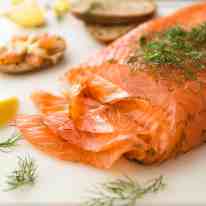
Cured Salmon Gravlax (it's so easy!)
Ingredients
- 1 tbsp white peppercorns (whole) (Note 1)
- 1 cup fresh dill, roughly chopped (1 big bunch)
- 250g / 8 oz rock salt (Note 2)
- 250g / 8 oz white sugar (Note 3)
- 1 kg / 2 lb salmon, sashimi-grade, bones removed and skin on (Note 4)
Mustard Cream Sauce
- 1/2 cup / 125 ml heavy / thickened cream
- 1/3 cup Dijon Mustard (or hot mustard if you want a kick)
- 2 tsp Mustard Powder
- Salt and pepper
To Serve
- Rye bread slices or other bread/crackers (Note 5)
- Lemon wedges
- 1/4 cup fresh dill, roughly chopped (for garnish)
Instructions
- Crush peppercorns with the side of a knife (or roughly grind using mortar and pestle).
- Combine peppercorns with salt, sugar and dill.
- Place 2 large pieces of cling wrap on a work surface, slightly overlapping. Spread half the salt mixture in the shape of the salmon.
- Place salmon on salt, skin side down. Top with remaining salt mixture.
- Wrap with cling wrap. Place in a large dish. Top with something flat (like small cutting board) then 3 x 400g / 14oz cans ("Weights").
- Refrigerate for 12 hours. There will be liquid in the dish. Turn salmon over (will be gloopy/wet)), then replace Weights and return to fridge. After another 12 hours, turn salmon over again, replace Weights. After another 12 hours, remove salmon from fridge. 36 hours total for Medium Cure - Perfect Gravlax to my taste (See Note 2 for description and more curing times).
- Unwrap salmon, scrape off salt then rinse. Pat dry. If time permits, return to the fridge for 3 - 12 hours uncovered (dries surface better, lets salt "settle" and permeate through flesh more evenly).
- Sprinkle over the 1/4 cup extra dill - for garnish and flavour.
- Slice thinly on an angle, do not cut through skin (i.e. don't eat skin). Serve with toasted bread, Mustard Sauce, extra dill and lemon wedges.
!Mustard Sauce
- Mix ingredients, making sure to season with salt and pepper. It should taste like a creamy mustard - a touch of tartness, but mostly to add moisture to the dish. You can add lemon juice and/or zest if you wish - I like to serve with wedges so people can adjust to their taste.
Recipe Notes:
* COARSE SALT / KOSHER SALT: 24 hours = Medium Cure, 36 hours will be between Medium and Hard Cure, 48 hours+ will be Hard Cure. Surface will be cured more (ie firmer, drier surface) than using Rock Salt because finer grains penetrate more. Highly recommend resting minimum 12, preferably 24 hours before serving - saltiness will distribute more evenly. CURING STRENGTH:
* Medium Cure (my preference) = surface is fairly firm and not too salty, inside is lightly cured, still moist (but not raw, it’s cured). Seasoned enough to eat slices plain.
* Hard Cure = surface is quite firm (like a soft jerky) and quite well seasoned, inside is slightly firmer and pretty well seasoned. Contrast between surface and inside more prominent. I find this a touch salty for my taste but is still way less salty than store bought. 3. Sugar, like salt, draws moisture from the flesh and cures it but makes it sweet rather than salty. Using normal sugar rather than superfine / caster sugar ensures that the salmon doesn't get too sweet (i.e. caster sugar penetrates salmon quicker). The right salt and sugar combination is key to controlling the saltiness of Gravlax while still achieving the "cured" effect and without making it too sweet! 4. Please ensure you use SASHIMI-GRADE salmon. I always ask, even if the sign says that! Nowadays in Australian coastal areas, sashimi-grade salmon is quite common at local fish mongers. Skin-on salmon means that the skin side is cured slightly less, however, for me, I prefer skin-on for this exact reason plus it's easier to carve. SMALLER FILLETS: The beauty of this recipe is that a little goes a long way! So you don't need to use a whole side of salmon, you can make this with a small fillet. However, if you get one smaller than 500g/1lb, then you'll need to increase the salt/sugar ratio to the weight of the salmon to ensure there's enough to cover the surface area. For a 300g/10oz piece, rather than using 150g/5oz combined salt/sugar, use around 210g/7oz (this is what I measured when I did a test using a smaller piece). I don't recommend going smaller than 300g/10oz because the width of the salmon will become too narrow and it will probably end up too salty. 5. Rye bread is the classic type to serve with Gravlax but it suits any bread or plain crackers. While some recipes recommend Pumpernickel Bread, I personally find that the flavour overwhelms the salmon. 6. EXTRAS: Some Gravlax recipes use lemon. Just add the zest of 1 - 2 lemons to the salt cure. This recipe is a classic one that doesn't use zest. 7. STORAGE: With the 36 hour cure, this salmon keeps for 3 days. Keep refrigerated in an airtight container. 8. SERVINGS: A little goes a long way with this recipe! It will comfortable serve 10 people as a starter. That's generous! 9. Nutrition is difficult with homemade Gravlax because I have no way of determining how much salt is infused into the flesh. So I've used a store bought Gravlax nutrition which is no doubt saltier than this recipe makes!
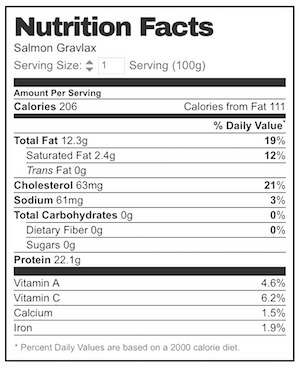 10. Recipe adapted from salmon curing guidance courtesy of Chef Massimo Mele. With my thanks for enduring my endless questions!!!
10. Recipe adapted from salmon curing guidance courtesy of Chef Massimo Mele. With my thanks for enduring my endless questions!!!Nutrition Information:
Life of Dozer
Fishing for salmon. Not. (There was a stick floating in the water. 🙄 And also a twig hanging off his privates???!!?)


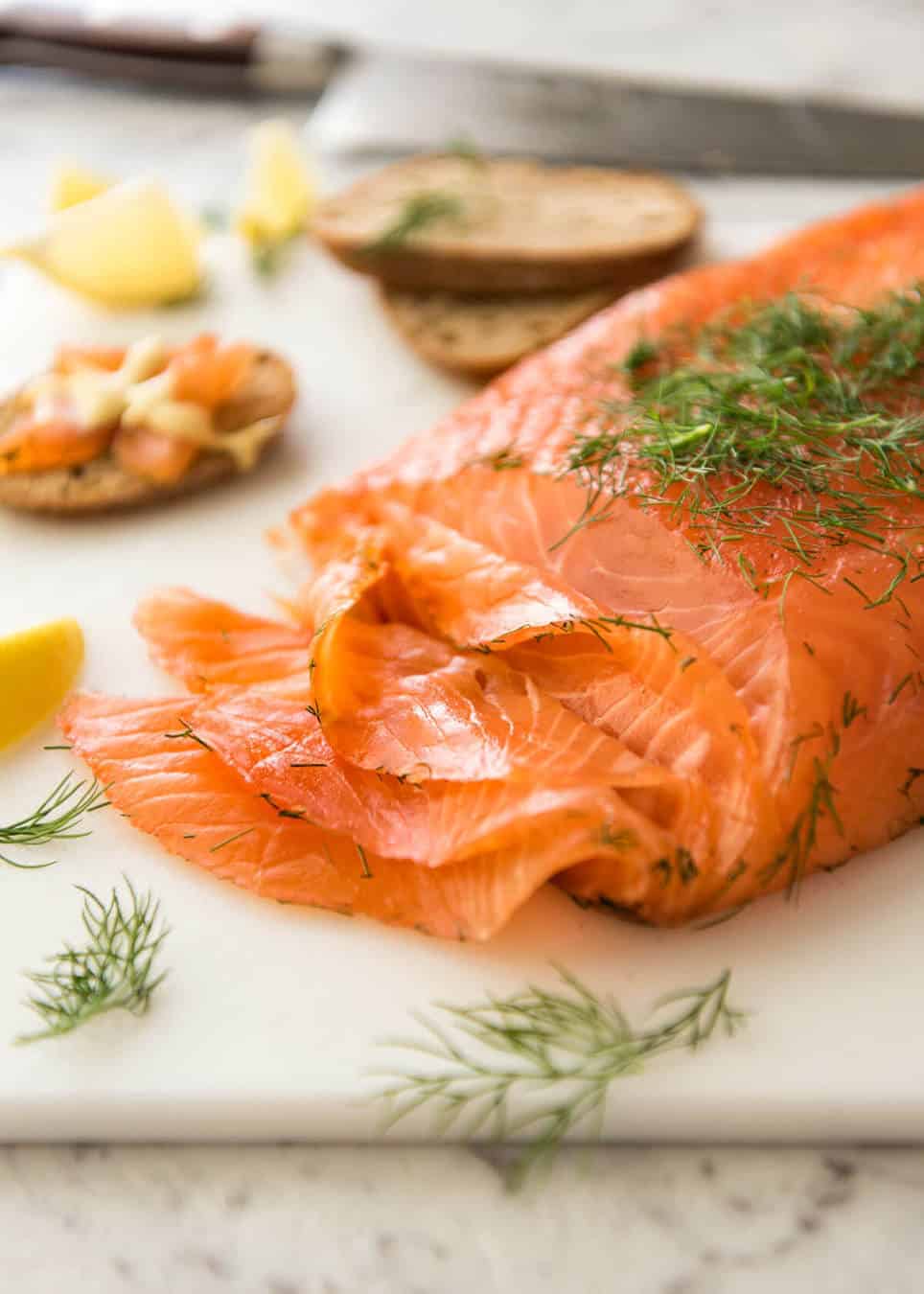
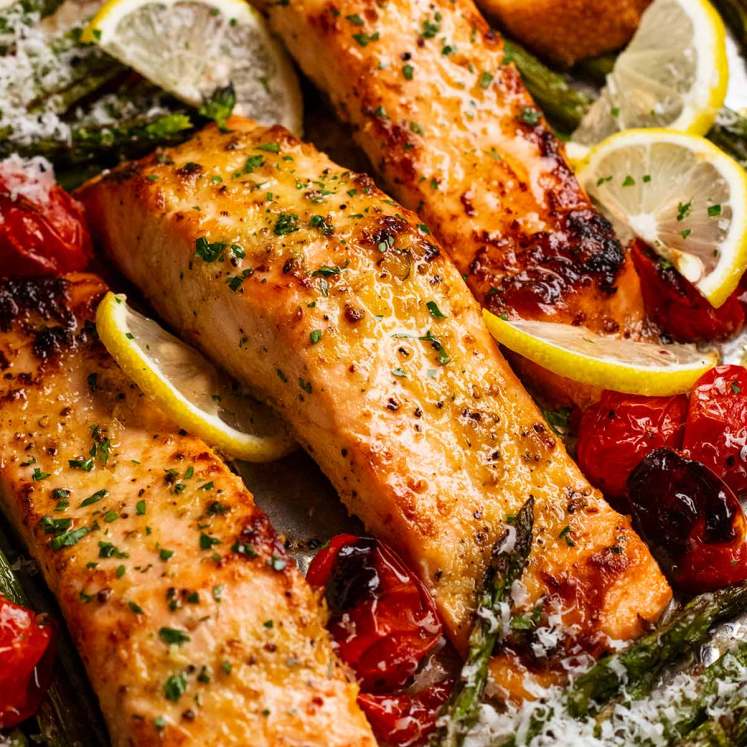
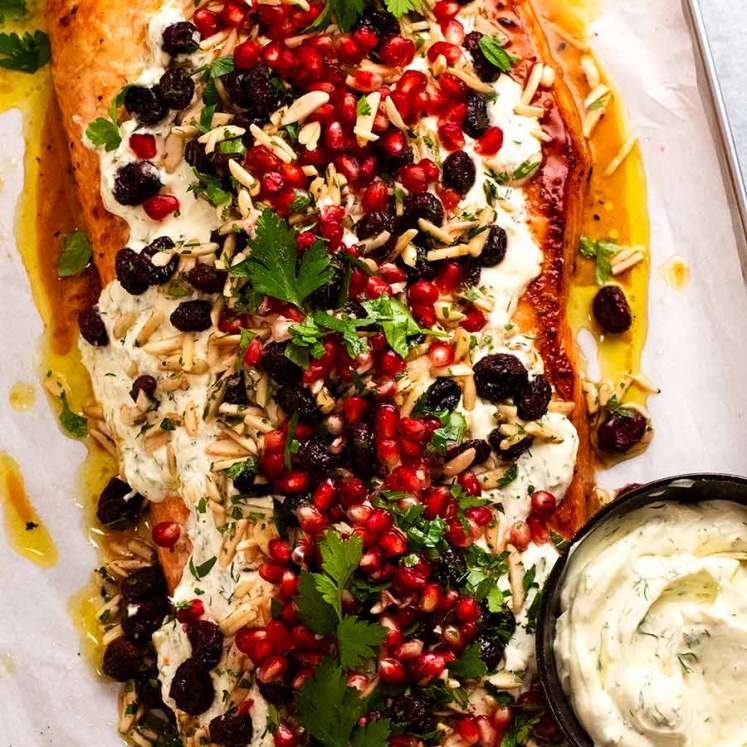

does it freeze after you cure it?
Hi Adrienne, yes you can actually freeze this for up to 2 months ☺️
I don’t recommend it unless you have a super strength commercial grade snap freezer 🙂 Generally as a rule, eating frozen raw fish isn’t advisable unless it’s been handled specially (eg if it’s sashimi grade from Japan it’s ok)
Great recipe! Thank you.
Hi! How can we adjust this recipe if we accidentally bought skinless salmon? Would appreciate your help! Made this once before and loved the way it turned out!
Hi! Tried this recipe once and loved it and wanted to make it again for our family holiday dinner. Problem – my brother not knowing the difference, bought skinless salmon. How do I adjust the curing mixture so that the salmon doesn’t turn out super salty etc.! Does it matter? Help!
Soooo yummy!
Help! I want to make this for 12/24 but my local fish market is closing from 12/20 until end of the year. If I pick up salmon on 12/19 in the morning, will it still be ok for 12/24?
I have another fish market in mind but it’s all the way in Los Angeles. Not looking forward to traffic lol. Lmk if you have any tips! Thank you!
Absolutely! This is what I would do: Cure it on 19th Dec evening 2.5 days. It will be cured a bit more than my base recipe which means it will last longer. So remove the salt on 22 Dec morning. Then that way it’s only stored for 2 days before you serve it and you can be confident it will be safe to serve – and good for another day afterwards. N x
Wow~!
This is a wonderful recipe!
I was able to make perfect Gravlax.
Perhaps in Korea, I can make the best Gravlax.
I really appreciate your recipe.
Dear Nagi,
I just wanted to let you know that I appreciated your recipe for cured salmon Gravlax.
This is why I mentioned it and your blog in my most recent article about Christmas Customs and Traditions in Europe. If you’re curious, you can visit the post by accessing the link below:
http://www.the-travel-bunny.com/christmas-customs-and-traditions-in-europe/
Thank you for sharing your wonderful recipes on RecipeTin Eats and keep up the good work!
I’m so glad you love the recipe and included it in your blog! Looks like a great collection of recipes!! ❤️
OMG! I can completely attest to how delicious and CRAZY EASY this is!!!!
My cousin and I planned to make this on Friday night then meet up for brunch on Sunday for an extra special brunch. However, the Friday night dinner party got a little out of control with the cocktails flowing, and we haphazardly slapped together this cured salmon at midnight.
LET ME TELL YOU! We didn’t screw it up (!!!!) AND we met up on the Sunday to devour it – it was DELICIOUS!
Thanks – will definitely make again!!!
YES YES YES!!!!!!!! zoo pleased to hear that Asako, thanks so much for sharing your feedback! N x
Going to make early next week.
Do you remove the liquid in the dish on each turning, or do you keep it in there until finished?
Hi Darce, just leave it there. The liquid is essentially more brine that cures the salmon. 🙂
Can this be used for lox and do croissants go good with this
Tried your cured salmon recipe this week with one deviation, I used icing sugar (only sugar I had on hand) and coarse salt. I went for the 48 hour cure and it came out perfect. It was less salty than the commercial (more expensive) salmon, I am really pleased.
HI , can i freeze the salmon after curing ?
You can freeze it between steps 5 and 6. Just remember to give it time to unfreeze (in the refrigerator!) before counting curing time. The curing starts, though, as soon as the surface has unfrozen. You can speed up the process a couple – maybe a few hours if you slightly push the salt/sugar/etc mixture into the flesh (I tend to use kosher sea salt, which is easy to press into the flesh). And no – it doesn’t leave coarse marks into finished food. Just remember not to “drill” the salt bits into it 🙂
I usually make it this way. Remember safe freezing times when it comes to fish, though.
Unfortunately not Vikas 🙂 N x
I have made gravlax numerous times and always using gravlax. WhT is the difference not using?
Your comments are so concise and Informative. The k you
I’ve been wanting to try my hand at gravlax for years. After looking at various recipes, this one caught my eye. It came out just great and was quite easy. The mustard cream sauce was even easier and I liked it, but I think it will overpower the fish if you don’t go easy on it. I spooned the sauce instead over steamed asparagus and boiled red potatoes. In any event, I will make the gravlax again.
That’s great to hear Murph! So pleased you enjoyed this! N xx
Great recipe!!! I’ve been preparing it for the last few months. One time, I ran out of ‘peppercorns’, so I used a mix of ‘black pepper’ and ‘Allspice’ which is a variety of sweet pepper from the Caribbean, Mexico, and the Central America region. Different, but also good. I do both now. -Thank you- !!!
That’s so great to hear!! Thanks so much for letting me know JC 🙂 N x
I am concerned that gravlax is manufactured from raw fish which might contain parasites which would be killed if the fish were cooked. Marinading is not effective in killing neither hazardous bacteria nor parasites. I prefer buying gravlax since fish industry has a better experience in choosing parasite free fish as compared to me. Just a thought…
If I use granulated sugar and coarse salt will it be too sweet or not work? I can’t find coarse sugar…
Hi Sarah! It will definitely work, it just cures faster. I would wipe the salt etc off at 36 hours. I literally just tried it this week with coarse salt and granulated sugar, left it for 48 hours and it was definitely too salty for my taste. 🙂
Hi Nagi,
Being that I am a lazy guy, I just make a mixture of 50% regular granulated sugar to 50% medium kosher salt and sprinkle on a layer of about 1/8″ (about 3 mm) to both sides of the fish, wrap it and cure it for about 48 hours.
When ready, I taste the fish, and if too salty, I place it in a pan, deeper than the height of the fish, and run cold water into the pan, making sure that it does not actually touch the fish, which would damage the flesh. Initially, I run the water for 12-15 minutes, then taste the fish again. This way, I always end up with the desired saltiness.
I read that 5 times over and I don’t get it – BUT I WANNA KNOW!!! How do you run water into a pan with the fish without touching the flesh?????
Nagi, when u flip the salmon within the 36 hrs do u remove the accumulated liquid or do u drain it @ the end? It sounds so yummy definitely will incorporate w/ Christmas brunch!
I plan on making this next week and was wodering…since the biggest grain salt makes it taste less salty, would turbid sugar make it taste less sweet? Can I use that if I don’t like sweet lox?thanks!
Hi Helena! Yep that’s right but I’m not sure how much less sweet it will make it 🙂 You could just use less sugar. But in all honesty, this is not sweet at all. It’s more that the sugar balances out the saltiness and enhances the natural sweetness of the salmon! N x
Hey
Do we need to buy sashimi/sushi quality salmon to do this recipe ?
Yes please Josh! Please see the recipe 🙂 N x